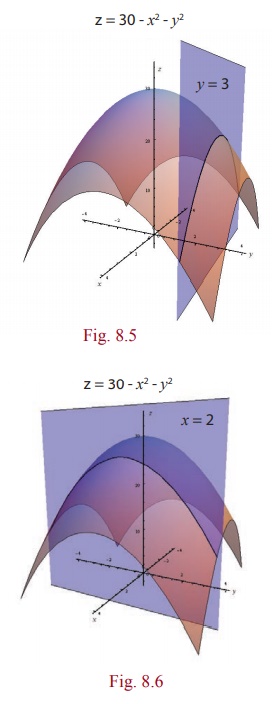Differentials and Partial Derivatives | Mathematics - Functions of Several Variables | 12th Maths : UNIT 8 : Differentials and Partial Derivatives
Chapter: 12th Maths : UNIT 8 : Differentials and Partial Derivatives
Functions of Several Variables
Functions of
Several Variables
Recall
that given a function f of x ; we sketch the graph of y = f
( x) to understand it better.
Generally, the graph of y =
f ( x) gives a curve in the xy
-plane. Also, the derivative f ŌĆ▓(a) of f at x = a represents the slope of the tangent
at x = a ,
to the graph of f . In the
introduction we have seen the need
for considering functions of more than one variable. Here we shall develop some
concepts to understand functions of more than one variable. First we shall
consider functions of two variables. Let F
( x, y) be a function of x and
y . To obtain graph F , we graph z = F ( x , y)
in the xyz -space. Also, we shall
develop the concepts of continuity, partial derivatives of a function of two
variables.
Let
us look at an example, g ( x, y
) =
30 ŌłÆ
x2 ŌłÆ
y2 , for x , y
Ōłł ŌäØ. Given a point ( x
, y) Ōłł ŌäØ2, then z = 30 ŌłÆ x2 ŌłÆ y2 gives the z coordinate of the point on the graph. Thus the point (x
, y, 30 ŌłÆ x2 ŌłÆ y2 )
lies 30 ŌłÆ x2 ŌłÆ
y2 high just above the
point ( x , y) in xy -plane. For
instance, for (2, 3) Ōłł
ŌäØ2 , the point (2, 3, 30 ŌłÆ
22 ŌłÆ 32 ) = (2, 3,17) lies on the graph of g . If we fix the value y = 3 , then g ( x, 3) = ŌłÆx2 + 21 which is a function that depends
only on x variable; so its graph must
be a curve. Similarly, if we fix value x
=
2 , then we have g (2, y) = 26 ŌłÆ y2
which is a function that depends only on y
. In each case the graph, as the resulting function being quadratic, will be a
parabola. The surface we obtain from z = g( x , y) is called paraboloid.
Note
that g ( x, 3) = 21ŌłÆ x2
represents a parabola; which is obtained by intersecting the surface of z = 30 ŌłÆ x2 ŌłÆ y2 with the plane y = 3
[see Fig. 8.5). Similarly g (2, y)
= 26 ŌłÆ y2 represents a parabola;
which is obtained by intersecting the surface of z = 30 ŌłÆ x2
ŌłÆ
y2 with the plane x = 2 [see Fig. 8.6). Following graphs
describes the above discussion.
z = 30 - x2 - y2 , z = 30 - x2 - y2

In the
same way, given a function F of a two
variables say x , y , we can visualize it in the three space
by considering the equation z =
F ( x , y) . Generally, this
will represent a surface in ŌäØ3.
Related Topics